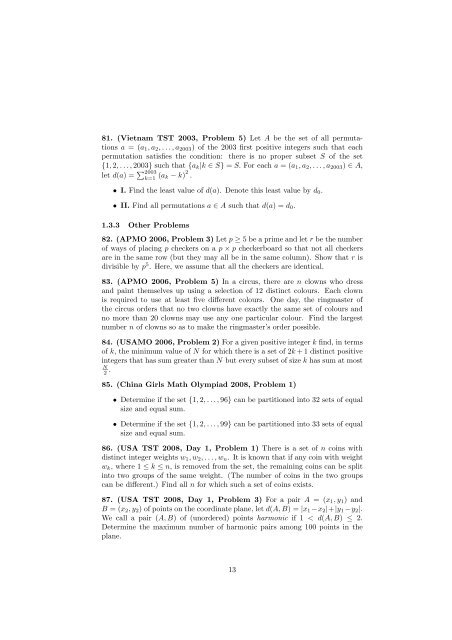Combinatorics Problems
Combinatorics Problems
Combinatorics Problems
You also want an ePaper? Increase the reach of your titles
YUMPU automatically turns print PDFs into web optimized ePapers that Google loves.
81. (Vietnam TST 2003, Problem 5) Let A be the set of all permutations<br />
a = (a 1 , a 2 , . . .,a 2003 ) of the 2003 first positive integers such that each<br />
permutation satisfies the condition: there is no proper subset S of the set<br />
{1, 2, . . ., 2003} such that {a k |k ∈ S} = S. For each a = (a 1 , a 2 , . . . , a 2003 ) ∈ A,<br />
let d(a) = ∑ 2003<br />
k=1 (a k − k) 2 .<br />
• I. Find the least value of d(a). Denote this least value by d 0 .<br />
• II. Find all permutations a ∈ A such that d(a) = d 0 .<br />
1.3.3 Other <strong>Problems</strong><br />
82. (APMO 2006, Problem 3) Let p ≥ 5 be a prime and let r be the number<br />
of ways of placing p checkers on a p × p checkerboard so that not all checkers<br />
are in the same row (but they may all be in the same column). Show that r is<br />
divisible by p 5 . Here, we assume that all the checkers are identical.<br />
83. (APMO 2006, Problem 5) In a circus, there are n clowns who dress<br />
and paint themselves up using a selection of 12 distinct colours. Each clown<br />
is required to use at least five different colours. One day, the ringmaster of<br />
the circus orders that no two clowns have exactly the same set of colours and<br />
no more than 20 clowns may use any one particular colour. Find the largest<br />
number n of clowns so as to make the ringmaster’s order possible.<br />
84. (USAMO 2006, Problem 2) For a given positive integer k find, in terms<br />
of k, the minimum value of N for which there is a set of 2k + 1 distinct positive<br />
integers that has sum greater than N but every subset of size k has sum at most<br />
N<br />
2 .<br />
85. (China Girls Math Olympiad 2008, Problem 1)<br />
• Determine if the set {1, 2, . . ., 96} can be partitioned into 32 sets of equal<br />
size and equal sum.<br />
• Determine if the set {1, 2, . . ., 99} can be partitioned into 33 sets of equal<br />
size and equal sum.<br />
86. (USA TST 2008, Day 1, Problem 1) There is a set of n coins with<br />
distinct integer weights w 1 , w 2 , . . . , w n . It is known that if any coin with weight<br />
w k , where 1 ≤ k ≤ n, is removed from the set, the remaining coins can be split<br />
into two groups of the same weight. (The number of coins in the two groups<br />
can be different.) Find all n for which such a set of coins exists.<br />
87. (USA TST 2008, Day 1, Problem 3) For a pair A = (x 1 , y 1 ) and<br />
B = (x 2 , y 2 ) of points on the coordinate plane, let d(A, B) = |x 1 −x 2 |+|y 1 −y 2 |.<br />
We call a pair (A, B) of (unordered) points harmonic if 1 < d(A, B) ≤ 2.<br />
Determine the maximum number of harmonic pairs among 100 points in the<br />
plane.<br />
13
















